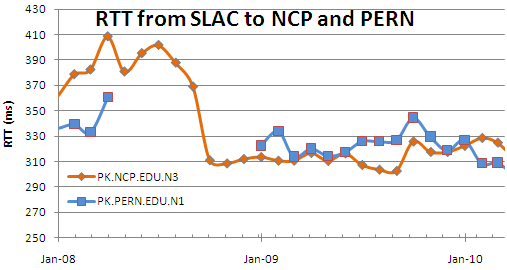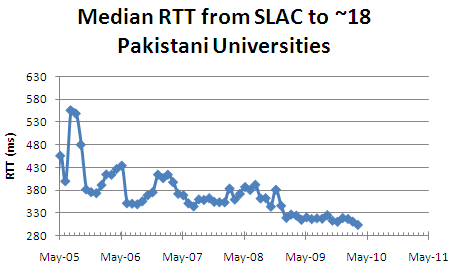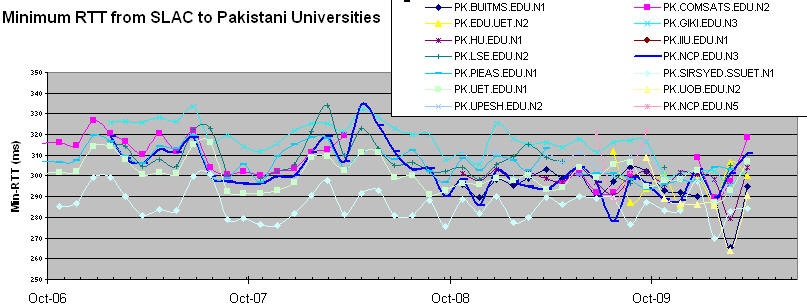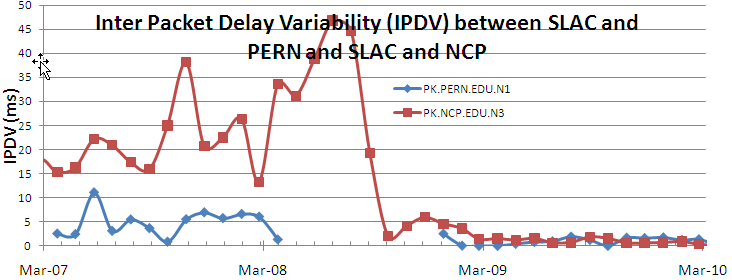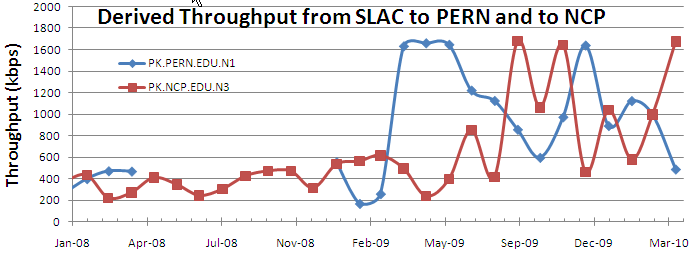...
The reason being that the IP addresses of our web servers are not being advertised on the TEIN3 network because of current bandwidth between TEIN3 and PERN2. The bandwidth of our TEIN3 link has being fully utilized by our research institutes, and we are at maximum utilization of the TEIN3 link. Due to the lack of bandwidth availability we have not made the PERN website available from TEIN3 network. That is the only reason for PERN website not being seen from the TEIN3 cloud.
Universities in Pakistan Seen From SLAC
On the other hand one can see from a plot of ping Round Trip Time (RTT) from SLAC to the National Centre for Physics (NCP) in Islamabad (NCP (see below) that during the month of October 2008 the RTT dropped from over 360ms to under 310ms.
The traceroute from SLAC to NCP appears to go through TEIN3.
Looking at the other Pakistani universities the median RTT seen from SLAC to about 18 Pakistani universities dropped from about 370ms to under 320ms between oct 2008 and April 2009, see below:
More details can be found in the spreadsheet of PingER measurements from SLAC to the Pakistani universities.
The Minimum RTTs from SLAC to Pakistani universities are shown below:
The Inter packet delay variation variability (IPDV) is shown below. It is seen that it has reduced (less jitter probably caused by reduced queuing and contention) considerably for NCP (a factor of 10 in October 2008). For other universities with a complete set of measurements, it can also be seen to have reduced at different times, for example UET (the University of Engineering and Technology in Lahore) reduced form from about 50ms to about 10 mis ms in October and November 2008 and PIEAS (Pakistan Institute of Engineering & Appliesd Applied Sciences in Islamabad) reduced from about 60 ms to about 10 ms in May 2009. On the other hand the Ghulam Ishaq Khan Institute (GIKI), in Topi on in the North West Frontier Province, appears to not have improved until March 2010.
The improvement in the PingER IPDV between SLAC and NCP (moved to TEIN3) and SLAC and PERN (not moved to TEIN3) can be seen in the plot below. It is seen that both have improved with time, though the improvement for NCP is much more dramatic. Both are now small and comparable and < 2 ms.
The derived throughput has improved by a factor of 5 since the start of 2008, however this does not appear to be directly correlated with the move to TEIN3.
South Asia TEIN3 hosts seen from NCP Islamabad
Looking at the Inter Packet Delay Variability from inside Pakistan (from the PingER NCP monitoring host at the Quaid-e-Azam University in Islamabad) to South Asian hosts connected via TEIN3, we see the plot below. It is seen that there are dramatic changes in the IPDV for the University of Peshawar. The interconnections between the Pakistani hosts probably do not use TEIN3 and so the improvements seen for Peshawar, SIRSYED and UET are probably independent of the TEIN3 link.
On the other hand if we look at IPDV from NCP to the TEIN3 hosts in Sri Lanka and India we can see the dramatic improvment in October 2008 for India and Sri Lanka. Unfortunately NCP was not monitoring the PERN host.
See the spreadsheet for more details can only measure the monthly loss rate down to 0.007% (since there are only 14400 pings = 10/30 min interval) thus the losses are no longer very instructive when the link performance improves beyond this level. In addition there is no obvious change in performance following Oct 2008.

